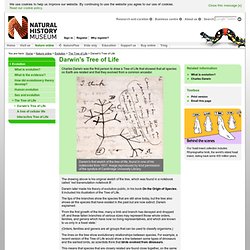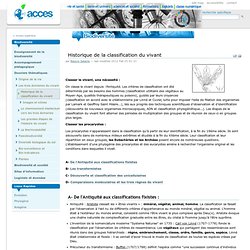

Arbre du vivant par Darwin, 1837. Darwin's Tree of Life. The drawing above is his original sketch of the tree, which was found in a notebook called ‘red transmutation notebook B’.

Darwin later made his theory of evolution public, in his book On the Origin of Species. It included his illustration of the Tree of Life. The tips of the branches show the species that are still alive today, but the tree also shows all the species that have existed in the past but are now extinct. Darwin explained: 'From the first growth of the tree, many a limb and branch has decayed and dropped off; and these fallen branches of various sizes may represent those whole orders, families, and genera which have now no living representatives, and which are known to us only in a fossil state.' (Orders, families and genera are all groups that can be used to classify organisms.) The lines on the tree show evolutionary relationships between species.
This means that species that are closely related are found close together, on the same branch. Arbre de l'évolution par Darwin, 1837. The Tree of Life. Return to "Download Files" Page You are welcome to download the following graphic image of the Tree of Life for non-commercial, educational purposes: Tree of Life (~3,000 species, based on rRNA sequences) (pdf, 368 KB) (see Science, 2003, 300:1692-1697) This file can be printed as a wall poster.

Printing at least 54" wide is recommended. Tree of Life tattoo, courtesy of Clare D'Alberto, who is working on her Ph.D. in biology at the University of Melbourne. The organisms depicted in this tattoo are (starting at 4 o'clock and going around clockwise): (1) a cyanobacterium (Anabaena); (2) a radiolarian (Acantharea); (3) a dinoflagellate (Ceratium); (4) an angiosperm (Spider Orchid); (5) a couple species of fungi (Penicillium and a yeast); (6) a ctenophore (comb jelly); (7) a mollusc (nudibranch); (8) an echinoderm (brittle star); and (9) a vertebrate (Weedy Sea Dragon). Here is another great Tree of Life tattoo! Cover of Molecular Systmatics, 2nd ed. Arbre du vivant. Historique de la classification du vivant.
Classer le vivant, une nécessité : On classe le vivant depuis l’Antiquité.

Les critères de classification ont été déterminés par les besoins des hommes (classification utilitaire des végétaux au Moyen-Age, qualités thérapeutiques ou poisons), guidés par leurs croyances (classification en accord avec le créationnisme par Linné et Cuvier, lutte pour imposer l'idée de filiation des organismes par Lamark et Geoffroy Saint Hilaire...), liés aux progrès des techniques scientifiques d’observation et d’identification (découverte de nouveaux organismes microscopiques, ADN et classification phylogénétique...).
Les étapes de la classification du vivant font alterner des périodes de multiplication des groupes et de réunion de ceux-ci en groupes plus larges. Classer les procaryotes : Les procaryotes n'apparaissent dans la classification qu'à partir de leur identification, à la fin du 19ème siècle. A- De l'Antiquité aux classifications fixistes B- Les transformistes haut_de_page B- Les transformistes. Arbre du vivant par Haeckel. Classification des espèces par Haeckel. Arbre de la vie (Terre) Arbre de la Vie.